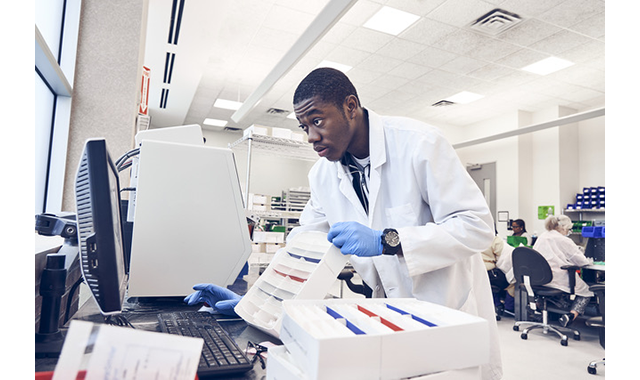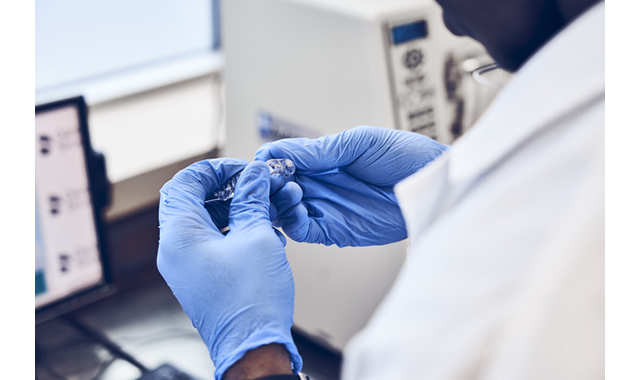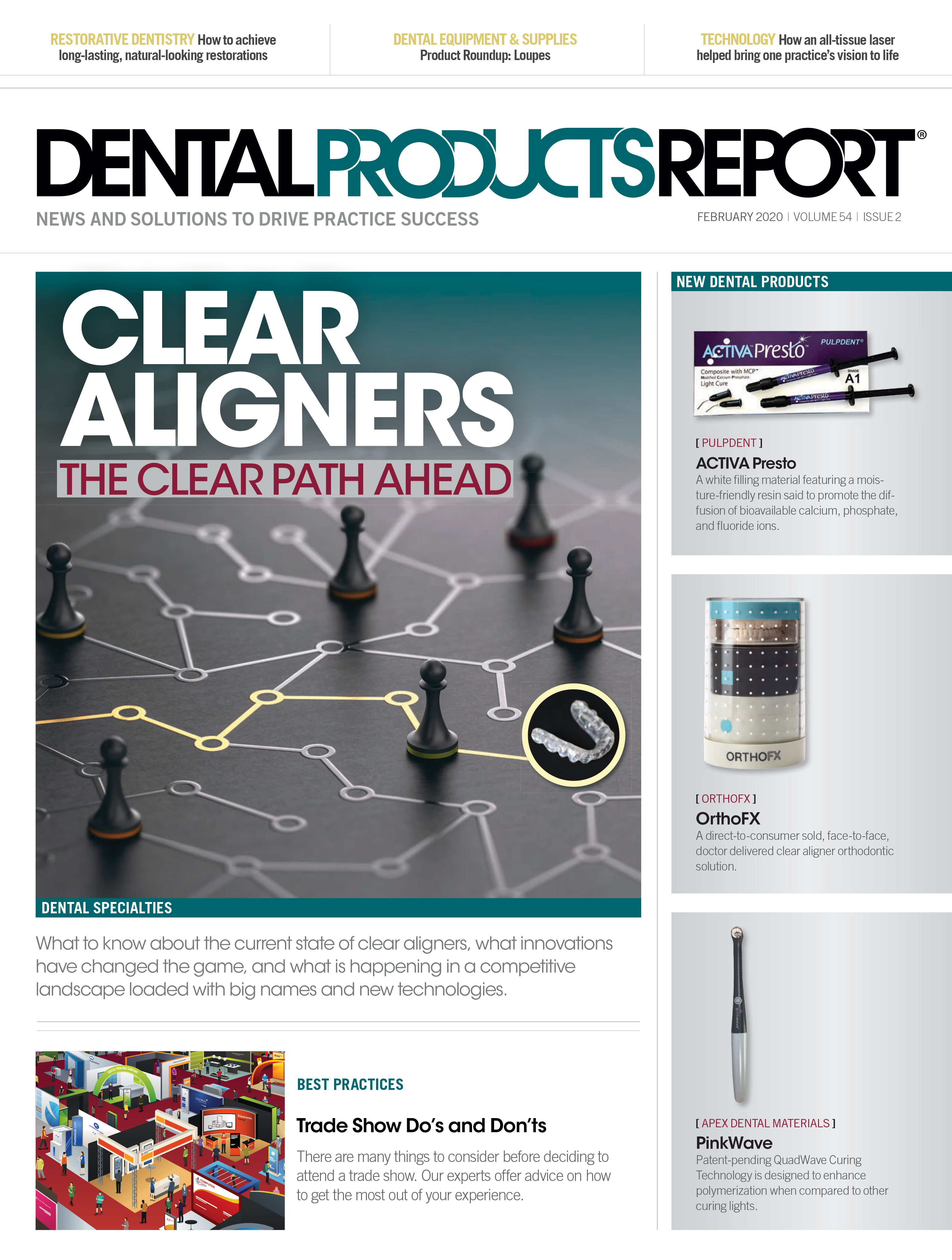Clear Aligners: The clear path ahead
Our experts share what they know about the current state of clear aligners, what innovations have changed the game, and what is happening in a competitive landscape that is host to big names in dental and disruptive new technologies. With new approaches and new players for clear aligners, what is the clear path ahead?

Digital clear aligner technology has been available as an orthodontic treatment for more than two decades, since Align Technology first introduced the Invisalign® system. Much has changed with the technology over time, including better materials, improved treatment planning, and more predictable outcomes. Moreover, the competitive landscape is changing, with new ways of marketing and delivering clear aligner therapy that have disrupted traditional doctor-led care.
While some form of clear aligner technology has been available as an orthodontic treatment for more than 20 years, quite a bit has changed with this technology over time, including superior materials, improved treatment planning, and more predictable outcomes. The changes in the industry’s competitive landscape have been just as impactful.
Despite all this, persistent misunderstandings remain in some dental professionals’ minds about who can do what when with clear aligner therapy. One expert described these ideas as having “staying power.”
With the developments and changes in suppliers for clear aligners, let’s take a closer look at the field of clear aligner technology today. From what you should know about clear aligners and choosing a partner, to technological innovations, to how competition is changing business as usual, here’s what some of the players in the industry had to say.
What you should know about clear aligners today
When Tera Poole, DDS, was going through dental school and residency, someone asked her, “If you could be a utensil, what kind of utensil would you be?” At that time, she thought it was a far-fetched question.
However, the clear aligner industry today reminds her of a utensil. Dr. Poole thinks of it as a three-pronged fork: One prong is the direct-to-consumer (DTC) players, another is the business-to-business (B2B), doctor-led clear aligner companies, and the third is the hybrid of both.
“It’s kind of like the Wild, Wild West right now,” Dr. Poole says. “Everybody is innovating in different avenues, and there’s so much going on, which makes it really exciting.”
Jerry Zilles, Vice President of Sales for Propel Orthodontics, has 20 years of experience in clear aligners, having been in the industry almost from the start. Zilles says if you haven’t had training on clear aligners in the recent past, you might be surprised to learn it is a different ball game than it was in the beginning.
Zilles sees many applications for general dentists regarding clear aligner therapy. From minor lower crowding to restorative cases to pre-implant cases, he says the possibilities with clear aligners are exciting.
“With the proper training you can do just about any case you wanted to with clear aligner therapy, no matter which company it is,” Zilles says. “They all have their different benefits, but in the right hands they can do just about anything traditional orthodontics could do.”
Christophe Carsault, vice president of sales for orthodontics and preventive for the Straumann Group, which owns ClearCorrect, says clinicians should know that clear aligners have almost become a plug-and-play for any practice. Having the right partner is crucial because the market potential is enormous.
Continue reading on the next page...
“Seventy to eighty percent of the population is suffering from malocclusion. It is a great service to offer to a patient,” Carsault says. “And there is no need to work to try to develop a very sophisticated marketing campaign for your practice because you already have the patients in-house.”
According to Align Technology, clear aligner technology offers millions of people around the world the opportunity for a beautiful, healthy smile. However, many do not realize that moving teeth through bone is a difficult process, requiring close doctor involvement, extensive knowledge, training, and experience.
Clear aligners are class II medical devices regulated by the FDA, and are an appliance prescribed by doctors.
“Invisalign clear aligner technology, pioneered by Align more than two decades ago, is helping to expand market growth by getting into the offices of general practitioner dentists to reach millions more people through technology rather than the manual process of bending wires and gluing brackets to teeth,” noted Frank Quinn, vice president, and general manager, U.S. of Align Technology.
Jeff Rohde, MS, DDS, who practices in Santa Barbara, Calif., has been working with Invisalign clear aligner treatment since 2004 and considers clear aligners a staple at his practice. Recently, Dr. Rohde started some new cases with SureSmile® from Dentsply Sirona, as well as some from OrthoFX™, and is excited about what he has discovered from the new companies.
OrthoFX is a hybrid of consumer-directed and doctor-led treatment. While the company is using DTC marketing to build the brand, the treatment has a doctor who handles the digital scan, the attachment placements, and monitors movement.
“They’re trying to find that sweet spot between the expensive Invisalign treatment and the haphazard nature of SmileDirect,” Dr. Rohde says.


Dentsply Sirona’s SureSmile provides technology that enables clinicians to provide treatments they might not otherwise.
Dr. Rohde says the most significant factor in whether a treatment works or not is patient compliance. If the patient wears the tray, then he thinks most treatments will probably work.
“If the patient only wears aligners at night and doesn’t have all the daytime pressure on his teeth, no system is going to work,” Dr. Rohde says. “Success is still based on patient compliance across the board.”
According to Align Technology, the Invisalign product portfolio can treat even the most complex orthodontic cases providing doctors with a range of products and price points available to treat their patients. The doctor determines which product to use and the price for the patient is based on treatment scope and complexity.
Continue reading on the next page...
While compliance plays an important role in the success of clear aligner treatment, many other considerations impact end results, according to Quinn. A significant factor in predictable, effective treatment is the efficacy of the product. This includes the digital treatment plan, the physical aligner, its features, and the materials it is made of, as well as the ability to manufacture a physical aligner that can express the desired movements prescribed by the doctor based on a diagnosis and treatment plan.
Zilles thinks more general dentists should consider offering clear aligner therapy in their practices. He says not offering it is doing a disservice to patients from a health standpoint. He sees benefits for patients ages 30 to 80, many of whom have lived with lower anterior crowding most of their lives.
“We need to realize that 50 is the new 30, and the patients are going to have these teeth for their entire lives,” Zilles says. “We can fix this today, and you can have straight teeth for the next 50 or 60 years.”
Through Align Technology, dentists have access to Invisalign Go, a system designed to help dentists incorporate Invisalign clear aligner treatment into their practices. Quinn explains that Invisalign Go provides support for case selection through treatment planning to help dentists treat mild to moderate cases as part of a comprehensive treatment plan.
“With tools on the iTero digital scanner such as the Invisalign Outcome Simulator and TimeLapse, patients, many of which are in the everyday dental hygiene chair, can easily visualize their future smile,” Quinn says.
Dr. Rohde says it is worth the effort to get educated and trained for doctors who haven’t been using clear aligners or who haven’t kept up on the changes with the treatment. Training is a crucial factor for success for general practitioners because dental school barely touches on the subject. “We learned enough to know that there is something called orthodontics, and that’s about it,” Dr. Rohde says.
However, many patients are looking to fix their smiles. Dr. Rohde says the success of SmileDirectClub shows that to be true. Moreover, many doctors have an excellent rapport with their patients, and patients would prefer to stay in the general practitioner’s practice rather than leave to see an orthodontist.
That said, Dr. Rohde still refers many adult cases to his orthodontist. Usually, it’s because he feels they are on the complicated side and need an expert overseeing the case.
“Not that you can’t do complex things with clear aligners. But some cases are best treated with traditional ortho,” he says.
Quinn notes that Align was first-to-market with Invisalign clear aligner technology 23 years ago and continues to be an innovator for the market. They have 952 active patents, per their website, and their technology has treated more than 7.5 million patients and they have provided hundreds of continuing education courses, including clinical support in every market speaking local languages. Align was the pioneer in clear aligner education and developing the biomechanics of tooth movement with clear aligners.
“Now, with such heightened awareness from the consumer perspective, it is driving additional opportunity for the practices,” Quinn says.
From a practical standpoint, Quinn says the most important thing to understand is not all clear aligners are created equal. In 2013, Align Technology introduced SmartTrack® material, designed specifically for tooth movement, which Quinn says was a significant change for the business and efficacy of Align Technology’s product.
“The massive innovations that went into not only the material itself, but also the system and the architecture to support it were game-changers for our business. But they were also a game-changer for the clinicians and the outcomes for their patients,” Quinn says.
Another critical change was when Align Technology made a significant investment in digitizing the front end of the process. Through the acquisition of the iTero product line in 2011, Align Technology fully digitized its clear aligner treatment process from start to finish.
“That meant no longer having to use the goo to start analog and then convert to a digitized process. It’s digital through and through,” Quinn says.
Continue reading on the next page...
What to know about clear aligners and restorative work
Zilles says with big suppliers such as Dentsply Sirona, Henry Schein, and Straumann in the mix with clear aligners, the potential exists to use clear aligners and Propel for movements prior to restorative work and pre-implant cases done in-house, or, for more advanced cases, referred out to a specialist. In the past, orthodontic treatment before restorative work wasn’t happening because treatment took up to two years with metal braces, and most dentists don’t want that long of lead time before placing a crown or implant.
Zilles works with the clear aligner companies to accelerate timelines for treatment with Propel’s product line. With the help of Propel’s in-office product for micro osteoperforations, and their take-home vibration unit, VPro, clear aligner treatment is accomplished faster, and a general dentist can rotate teeth or create space needed for the restoration in weeks rather than years.
“To be the best dentist you can be, you need not only clear aligners but also you need treatment to be five visits or less versus two years of orthodontic treatment,” Zilles says.
According to Quinn, when doctors start with an iTero scan, they have new opportunities to provide their patients with a better understanding and view of their current and future smile.
“We are working on digital communications tools, from visualization of treatment through in-depth treatment planning including restorative smile design to patient interaction and building the digital workflows to support however a doctor may want to practice,” Quinn says.
Moving teeth results in many benefits to the patient. Hygiene improves because it’s easier for them to clean their teeth. Occlusion improves to create better contact with the restoration, so their teeth last longer. Also, no matter how skilled the dentist is, veneers need replacing after 20 or 25 years. Patients who had their teeth straightened instead of veneers might get away with only wearing a retainer, Dr. Rohde says.
“We often start an esthetic case by moving the teeth back to where they should be,” Dr. Rohde says. “When the orthodontic treatment is done, do a full esthetic evaluation of where the patient is, then. You might do a mix of bonding and veneers and whitening, too, but you’ve kind of idealized the situation first.”
Dr. Rohde says everyone has patients looking for this kind of care. Clear aligners represent a clinical opportunity to care of your patients. They also broaden your treatment options. Many times Dr. Rohde idealizes the position of the teeth with clear aligners before restoring with porcelain. It not only restores function and occlusion to help the restorations last longer, but the restorations can also be more conservative.
“In other words, maybe we’re doing conservative veneers rather than full wrap-around crowns,” Dr. Rohde explains. “Or, for lower anterior crowding, rather than chopping those tiny teeth down, we move them to a better position, and then that related restoration lasts longer.”
Dr. Rohde says clear aligners used in combination with his laser and CEREC technology help him keep more of the cases in-house. He thinks other practices could, too.
“With good training, everyone can do this,” Dr. Rohde says. “What we’re doing isn’t that hard. We just have the tools to do it.”
Continue reading on the next page...
The clear aligner innovations you should know about
Zilles says some general dentists don’t want to get into orthodontics. Moreover, their patients don’t want to get treatment because they mistakenly believe it will take two years to complete. However, all the companies have unique ways to make clear aligner treatment more efficient and cost-effective for the practice, and more predictable and quicker for the patient. Some companies are expanding their sales force to train doctors on how to be more profitable using clear aligners to correct smiles. Some offer a low-cost tier for more straightforward cases, while others have options to make trays in their practice.
“The biggest innovation, I believe, has been the different product offerings based on case difficulty,” Zilles says.
In addition to their product features, Carsault says ClearCorrect is introducing innovative new technology to make it easy for GPs to use their product.
“ClearCorrect was created by GPs for GPs in the first place. Our roots are here,” Carsault says.
Using Carbon additive manufacturing platforms, Dentsply Sirona is able to produce thousands of clear aligners a day.

Carsault says artificial intelligence (AI) will play a significant role in innovation for clear aligners as well as dentistry as a whole. He sees its impacts for clear aligners in the form of accurate treatment planning and connecting patients to the dentist. AI will help GPs treat orthodontic cases like a pro, as well as raise the patient consciousness with initial assessments about what can be addressed with the treatment.
“AI is already everywhere in our daily life as a consumer. It is what is going to support the market moving forward,” Carsault says. “It will not replace the dentist; it will elevate the game of the dentist.”
Align Technology has the most data available from past cases and uses AI and machine learning to predict how teeth will move using the Invisalign system. With more than 7.5 million cases to pull from, Align Technology has a lot of data to drive the accuracy of their treatment plans, help improve outcomes, and fuel further innovation. Quinn says recent new product launches for Invisalign First and Invisalign treatment with mandibular advancement were driven from decades of experience and data.
“The extensive data generated by AI and machine learning gives that clinician confidence that the treatment plan and the Invisalign system is going to produce that outcome in the end,” Quinn says. “That advantage helps us drive the future innovations of our products to have more applications for different types of malocclusion that are showing up in the practices every day.”
Invisalign First treats young and growing children with mixed dentition. AI technology recognizes erupting teeth and dentition and is used to build clear aligners to manage tooth movement through those growing stages. In Q3 of 2019, the Invisalign system was used to treat more than 130,000 teenagers and children as young as seven with their system through the doctor. They have treated almost two million teens and young patients in their history.
“The innovation is there. There is an available appliance for those growing children and teenagers,” Quinn says of Invisalign First.
With mandibular advancement, Invisalign aligners have wings included to address Class II malocclusion. Now, Quinn says 70 to 80 percent of all malocclusions can be treated with the Invisalign system.
“AI helps drive those innovations and broadens our capability and efficacy to treat more complex types of malocclusion,” Quinn says.
With good training, everyone can do this. What we’re doing isn’t that hard. We just have the tools to do it.”
-Jeff Rhode, MS, DDS, who
practices in Santa Barbara, Calif.
SureSmile is also using AI to automate the routine tasks in treatment planning and preparation. For example, the SureSmile software is seamlessly connected to the Primescan intraoral scanner. They are bringing more tasks chairside from the central software, hosted on the cloud to allow dentists to show treatment simulations chairside. The goal is to produce seamless integration, which leads to faster turnaround times, enhances patient communication, and produces more efficient treatment timelines. Mondou says most of the time, it will be invisible to the practitioner.
“Invisible, yes, except that they will do things faster,” says Dominique Mondou, who manages orthodontic platforms and marketing for Dentsply Sirona. “And there is a point where tasks that we’re doing in the lab will be done chairside because we’ve also made use of these technologies.”
Plans for innovations at SureSmile include treatment monitoring with the auto-track software module as a way to engage more with the patient. For example, when patients come in, the team would rescan with Primescan in a few seconds and then compare the treatment plan with the actual position of the teeth to ensure the treatment is on track.
Continue reading on the next page...
“This helps the practitioner to track the treatment, so we get that GPS mindset of making sure we’re on the right track. And, on the other side, it’s also engaging with the patient and showing whether their treatment is right on target, or maybe that something is not happening,” Mondou says. “It’s a great communication tool.”
Another significant innovation SureSmile is working on is to facilitate collaboration in Dental Service Organizations (DSOs) and group practices. With digital technology, the team can share cases to split between treatment plan and treatment execution. For example, if a DSO has an orthodontist and multiple general practitioners, the GP can have the specialist validate their treatment plan and handle the execution themselves.
“You can increase collaboration and leverage your resources in a large, multi-practice group,” Mondou explains. “This is an area where we’re working heavily, as we believe there will be more collaboration like this moving forward.”
“Align works with a number of DSOs throughout the U.S. and Canada,” Quinn says. “We collaborate with our DSO partners and provide them with education and training on Align’s digital platform along with co-marketing activities and more to support their doctors and help them drive interested consumers to their dental practices for treatment.”
Carsault also sees that innovation in the clear aligner space will center around patients. It will help dentists, but it will also educate patients in a simple way about what can be done to improve the form and function of their smile.
“The patient needs to be in the center of what we are doing because, again, we are doing that for them,” Carsault says.
Dr. Poole is working with Uniform Teeth, a clear aligner company based in San Francisco. The biggest differentiator with Uniform Teeth is its balance of technology solutions to provide doctor-led care.
“We have a team of engineers that are working on proprietary trading and planning software. We have this whole vertical integration where you don’t have to put the pieces together,” Dr. Poole says. “We can focus as clinicians on providing that standard of care that we want to provide, and Uniform brings the ecosystem to us.”
Uniform Teeth uses telehealth, and the platform centers around dedicated orthodontists from top universities overseeing in-office care. Patients use an app-enabled remote check-in every week.
“We have the app and the monitoring so we can have fewer appointments. But, at the same time, our clinicians see four to five times more patients than a typical orthodontist, although still only seeing 16 patients a day. That is possible due to the incorporation of our technology in the integration we have, along with our team planning software,” Dr. Poole says.
Another innovation Uniform Teeth is introducing in their national roll-out next year is the patient app. Their app integrates into the electronic health system, which is in-house and proprietary. They can capitalize on this by reducing the number of in-person visits. They switch the tray and send in a picture. Then the doctor replies about whether the case is tracking, and, if it isn’t, what to do about it.
“There have been instances where patients lose the tray, or we need to adjust something, and these are tasks you can’t facilitate on all these other platforms, which is interesting,” Dr. Poole says. “We have our team of customer support and care teams that are there to engage with patients directly, monitor their care, and ensure they get quality dentistry.”
Clinicians using the Invisalign system also have access to cutting edge software tools designed to make the process easier. The ClinCheck software provides a 3D digital plan from start to finish to provide seamless digital treatment planning.
“Doctors using the Invisalign clear aligner system have access to Align’s ClinCheck software, a powerful and sophisticated tool that supports treatment planning and monitoring,” Quinn says.
The clear aligner marketplace changes you should know about
Dr. Poole thinks there are two primary challengers to the established brands. Some, for example, bypass clinicians. However, she does not think those challengers will succeed in the long run.
Excellent treatment planning can result in a faster treatment or one where there is less refinement necessary at the end.

“Moving teeth is very serious, and not having that health care oversight eventually is going to show the hazards involved with that,” Dr. Poole says. “To maintain their value, established brands will have to continue to educate patients about the value of having that in-person care and what that means.”
The second type of challenger embraces clinicians. Some target the entrepreneurial dentist and help them manufacture the aligners and providing treatment planning software. The battle there is that clinicians want to control and prefer to switch it, so they control the treatment plan, Dr. Poole says.
“They’re going to have to shift and give more control to the clinicians,” she says.
Dr. Poole says understanding the risks and downsides of both, as well as the benefits of the systems, is essential to the next movement in clear aligner therapy. Clear aligner companies need a treatment plan, to manufacture the aligners, and give control to clinicians for individualized care. Uniform Teeth is capitalizing on all of these.
Continue reading on the next page...
“Everything’s centered around the orthodontist and that patient care. So I think our type of interest is going to be more challenging to the brands that exist, and it’s going to bring something different. That is not already out there,” Dr. Poole says.
Another influence of the many competitors is that the way clear aligner patients communicate with their dentist might change. In the direct-to-consumer (DTC) model, many providers are integrating the dentist early on, which can lead to a new type of treatment. Carsault sees that some form of this relationship has a place in the market and he is not going to fight it, but instead find ways to make it work for consumers and dentists.
We need to realize that 50 is the new 30, and the patients are going to have these teeth for their entire lives. We can fix this today, and you can have straight teeth for the next 50 or 60 years.”
-Jerry Ziles, vice president sales,
Propel Orthodontics
“In the future, you will see that the DTC model is going to stick around. That’s the model that patients want. So, this is also on us to be creative and bring some solutions to our dentists for them to provide the right services,” Carsault says.
Mondou believes there is a significant market for the DTC organizations to treat uncomplicated cases for an expected price for a patient that maybe would never go to a dental office because they think it’s too expensive. While he recognizes that orthodontic associations are challenging that clinical approach, the market is there. Mondou says as a manufacturer, Dentsply Sirona has a responsibility to offer a solution to clinicians.
“We see ourselves as empowering professionals and giving them the tools to be efficient and to deliver good care,” he says. “If there is a market that needs to be addressed this way, we need to look at it and provide tools, solutions, software, and devices to enable professionals to address that market.”
Mondou sees that DSOs are best equipped to address this market because of their efficiency and operation model. Digital technology allows them to leverage expertise in a much more efficient, even disruptive way across the country and multiple disciplines.
“I think they have a strong value to offer to the market,” Mondou says of DSOs.
Also, Mondou says that because the medical and health care business is becoming fully digital, it will transform how it is done and how people behave. He compares it to how banking has changed from brick-and-mortar into coffee shops where you can do everything online. Likewise, the health care business is becoming more consumer-driven, and digital technology is transforming how they handle it.
“So, as a manufacturer, we need to be the one partnering with these organizations, partnering with the professionals and helping them adjust to that and deliver the right solution to the patient,” Mondou says. “We look at it as a win-win partnership with the professionals.”
Quinn thinks one of the benefits of having more competition is the heightened awareness it creates around clear aligner therapy. He sees a tremendous amount of untapped potential for doctors, their patients, and Align Technology, the most massive 3D printing operation in the world, with more than 454,000 Invisalign clear aligner trays produced per day.
Quinn says a clear differentiator for Align Technology is the Invisalign brand.
In the end, the doctor has to choose. He advises clinicians to understand the differentiators from one plastic to the other. Also, the platform drives the system and how well it’s integrated to deliver patient outcomes, as well as the support needed.
“The thing that matters most is that the patient outcome is exactly the way it should be,” Quinn says. “This happens through a combination of our advanced treatment planning, doctor education, SmartTrack technology, and consumer marketing to build awareness and drive demand to the doctor’s office. We strive to be the best possible partner to our doctors and provide them with the right resources to help their patients and grow their practices.”
Carsault is excited about the new competition entering the clear aligner space because it creates more discussion around clear aligners and treatment plans. He says it will create more market for everybody.
“We have to acknowledge that we didn’t even scratch the surface off the addressable market in North America,” he says. “So, we are super excited to see that all together. We are going to bring more discussion, innovation, and more value proposition for patients.”
Continue reading on the next page...
What you should know about choosing a clear aligner partner
Dentsply Sirona, the largest manufacturer of professional dental products and technologies, acquired OraMetrix and its SureSmile technology in March 2018. Dominique Mondou, vice president traditional orthodontics and OraMetrix, manages platforms and marketing of orthodontic products for Dentsply Sirona. Mondou says there are three things about clear aligners clinicians should be asking themselves:
1. How does treatment planning work?
2. Do you have control over how the teeth move, and will it achieve what you want?
3. Who’s the partner that’s going to help me implement that into my practice?
Mondou says the ability to predict the before and after workflow, and the outcome are essential considerations for any clinician choosing a clear aligner partner. Also, it is vital to understand how you deliver the movement of each tooth.
“I like to compare it to driving in a place you’ve never been. You might have a fantastic car, but if you get a bad GPS, you end up lost or losing time and maybe not getting where you wanted to go,” Mondou says.
Mondou says treatment planning relies on the concept of “garbage in, garbage out.” In other words, the better the treatment plan, the better the treatment execution will be. Excellent treatment planning can result in a faster treatment or one where there is less refinement necessary at the end. In practical details, he says patients often ask how we approach the treatment planning, “So, do you have fewer attachments than we do now?
“SureSmile is known for that. A lot of our heavy users comment about it,” Mondou says. “Because we know quite well the biomechanics and the treatment, we can reduce the number of attachments, and the attachment is the less esthetic part of the treatment.”
Align Technology’s SmartForce attachments are small, tooth-colored shapes that are bonded to the patient’s teeth before or during their Invisalign treatment.
Attachments engage with the Invisalign aligners to deliver forces to the teeth to provide the optimal orthodontic tooth movement.
Align explains that in order to move teeth with clear aligners predictably and effectively, especially roots, you need attachments to achieve the desired movements. Invisalign clear aligners fit smoothly around the SmartForce attachments, so they’re barely noticeable.
The second thing Mondou recommends is looking at how much control you have over the treatment, so you can deliver the quality of care that you want. However, being in control means different things to different dentists.
“A specialist might want to be in control of the degree of rotation of that tooth, the exact details. For somebody else, being in control might mean, ‘If I have a question, I need support to back me up,’” Mondou says.
Having a dependable partner is the third vital consideration per Mondou. He says at SureSmile, their philosophy is to provide you technology that enables you to do things you might not do otherwise. So while the most advanced specialists can use their products, they also can help educate and guide a general practitioner to provide quality care they might have referred out before.
“And it goes from training the doctor on the software and the treatment planning tools to the clinical builds to helping the assistant treatment coordinator, and even how well they integrate that process into the regular process of the practice,” Mondou explains of the partner support Dentsply Sirona offers for GPs.

Mondou says training and maximizing the use of technology is in the DNA of the company. He says it is an essential thing to have superior technology backed by expertise, but training users to maximize the system is also vital.
“We are using more and more solutions to share knowledgeÂÂ-from one-on-one eLearnings to large events that are focusing on maximizing the utilization of the system. So, we have a very broad range,” Mondou says.
Align Technology agrees that training is crucial. They would also say what type of treatment planning and educational support your clear aligner partner provides to support you and your practice is key.
There are four areas general practitioner Dr. Jeff Rohde suggests you consider when selecting a clear aligner supplier or partner, which include price, technology compatibility, educational opportunities for you and your team, and support.
When it comes to price, Dr. Rohde says it is essential to understand how your partner will charge you and what is-and what is not-included in that fee for each case. It is also essential to understand if your technology is compatible with the clear aligner’s system or if you will need to invest in new equipment to submit cases.
Additionally, it is crucial to understand what kind of training you will get, not only on the company’s technology but also evaluating occlusion and what to move when correcting smiles, too. Dr. Rohde suggests you find out if there is an opportunity for the staff to receive training, too, because they will be hands-on with much of the process.
“The fourth thing would be support. Do you have someone there when something goes wrong, you have questions, you need to expedite something, or something’s not working?” Dr. Rohde says.

Product Bites – November 3, 2023
November 3rd 2023The weekly new products podcast from Dental Products Report is back. With a quick look at all of the newest dental product launches, Product Bites makes sure you don't miss the next innovation for your practice. This week's Product Bites podcast features new launches from Premier Dental, Denti.AI, and Clear Correct. [3 Minutes]